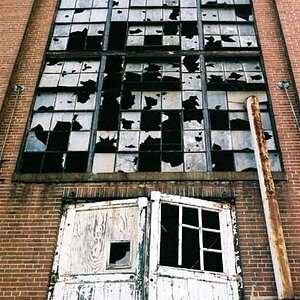Navigation
Install the app
How to install the app on iOS
Follow along with the video below to see how to install our site as a web app on your home screen.

Note: This feature currently requires accessing the site using the built-in Safari browser.
More options
You are using an out of date browser. It may not display this or other websites correctly.
You should upgrade or use an alternative browser.
You should upgrade or use an alternative browser.
Why no olmpuses?
- Thread starter Vautrin
- Start date
I
Iron Flatline
Guest
Material and manufacturing costs are rarely the bulk of the cost, except maybe in high-end Swiss watches. The real cost is in R&D, marketing, and (recently) distribution.
Vautrin
No longer a newbie, moving up!
- Joined
- Jun 26, 2008
- Messages
- 927
- Reaction score
- 58
- Location
- It changes
- Website
- www.withoutamapphotography.com
- Can others edit my Photos
- Photos OK to edit
Also if everyone stopped buying stuff what would that do to the economies of the world. I assume you all know how the fractional reserve system works with inflation and deflation etc....
If people stopped buying as much of some thing because it was manufactured better, they'd buy more of other things, or save / invest their money -- which would get loaned to someone who would then buy something useful. The reason that we don't see higher quality goods is not that the economy needs constant churn to keep chugging along, but that the masses would rather something cheap that has to be replaced then something expensive that can be kept forever...
Bifurcator
TPF Noob!
- Joined
- Jun 1, 2008
- Messages
- 3,312
- Reaction score
- 1
- Location
- Japan
- Can others edit my Photos
- Photos OK to edit
If people stopped buying as much of some thing because it was manufactured better, they'd buy more of other things, or save / invest their money -- which would get loaned to someone who would then buy something useful. The reason that we don't see higher quality goods is not that the economy needs constant churn to keep chugging along, but that the masses would rather something cheap that has to be replaced then something expensive that can be kept forever...
Yeah, I think that's probably true. I wasn't speculating as to why or why not seals weren't in all models tho... Just commenting on what the costs might be in an attempt to answer prodigy2k7's inquiry about that.
If asked though I guess I would opt for having seals in all models - I mean as a consumer.
Hawaii Five-O
My alter-egos have been banned. :( Now I must be
- Joined
- Jun 2, 2008
- Messages
- 1,099
- Reaction score
- 0
- Can others edit my Photos
- Photos OK to edit
I wish everyone on Earth would just stop buying cameras (or anything) for a few weeks
Thats hard to do while learning about photography here on TPF.
You are all evil,evil people for putting ideas into my head to buy more camera and photo equipment! haha just joking.
Vautrin
No longer a newbie, moving up!
- Joined
- Jun 26, 2008
- Messages
- 927
- Reaction score
- 58
- Location
- It changes
- Website
- www.withoutamapphotography.com
- Can others edit my Photos
- Photos OK to edit
If asked though I guess I would opt for having seals in all models - I mean as a consumer.
If every single consumer demanded such, it would be included.
Honestly I thought all cameras were too delicate to go into the rain until today.
Most people probably do to -- which is why unless you're looking at a pro camera you probably never see advertisements of weather sealing
Bifurcator
TPF Noob!
- Joined
- Jun 1, 2008
- Messages
- 3,312
- Reaction score
- 1
- Location
- Japan
- Can others edit my Photos
- Photos OK to edit
Sounds like reasonable logic to me. I agree.
 So let's start an awareness campaign: Metal Bodies, and Whether Seals for all.
So let's start an awareness campaign: Metal Bodies, and Whether Seals for all. 
Oh, and let's standardize ALL lens mounts while we're at it. :lmao:
Oh, and let's standardize ALL lens mounts while we're at it. :lmao:
skeletonman
TPF Noob!
- Joined
- Sep 14, 2007
- Messages
- 14
- Reaction score
- 0
- Location
- Singapore
- Can others edit my Photos
- Photos NOT OK to edit
I am using E510 for more than a year now, this is my first DSRL. So far this camera serves me well, been with it to so many countries with it.
Yes it does not have that many lens like Nikon or Canon, but again...do we really need that MANY lenses??? For me, I have a 300-600 mm zoom lens, a 50 mm macro, a 12-60mm and a 45-150mm(If I remember the numbers are correct lol). All these lenses served me well. Ok I am not a pro maybe I might be wrong in the number of lenses needed.
I am not a technical experts in the format of 4/3 format, but it offered me small size DSLR and I have no problem printing it if you print it in JUMBO 4R. I have done wedding shots and printed it.
But what I have to say is that Olympus produced fine cameras. Why nikon or canon? I think its because when people think of Cameras they will think of these 2 brands just like when you talked about fast food...people will think of Mac. Not that I am saying their other 2 are bad. I believe each system has their strength and weakness.
Its up to the person behind the cameras to produce great photos and not by having what kind of equipements u have.
I have gotten the Olympus Mju 1030sw and brought it for my trip to snorkling in the sea. Hey it did not fail me! I took great pictures underwater and video too. some people think that hey are you crazy to go into the water with a digital camera? lol..
Yes it does not have that many lens like Nikon or Canon, but again...do we really need that MANY lenses??? For me, I have a 300-600 mm zoom lens, a 50 mm macro, a 12-60mm and a 45-150mm(If I remember the numbers are correct lol). All these lenses served me well. Ok I am not a pro maybe I might be wrong in the number of lenses needed.
I am not a technical experts in the format of 4/3 format, but it offered me small size DSLR and I have no problem printing it if you print it in JUMBO 4R. I have done wedding shots and printed it.
But what I have to say is that Olympus produced fine cameras. Why nikon or canon? I think its because when people think of Cameras they will think of these 2 brands just like when you talked about fast food...people will think of Mac. Not that I am saying their other 2 are bad. I believe each system has their strength and weakness.
Its up to the person behind the cameras to produce great photos and not by having what kind of equipements u have.
I have gotten the Olympus Mju 1030sw and brought it for my trip to snorkling in the sea. Hey it did not fail me! I took great pictures underwater and video too. some people think that hey are you crazy to go into the water with a digital camera? lol..
Last edited:
usayit
No longer a newbie, moving up!
- Joined
- Nov 15, 2003
- Messages
- 9,521
- Reaction score
- 347
- Can others edit my Photos
- Photos OK to edit
But then you hang it in that trendy storefront in NYC where it costs $500 / sqft / month and you start to see where the real costs come in.
No.. you misunderstand. I'm talking about clothing at Kohls, targets... your regular clothing stores. I don't spend money on clothing.... Those trendy storefronts play a relatively small part in the market. Its the clothing that millions purchase that really make a difference.
pez
Been spending a lot of time on here!
- Joined
- May 29, 2008
- Messages
- 1,890
- Reaction score
- 1,589
- Location
- N Georgia
- Can others edit my Photos
- Photos OK to edit
If I started over, I would want a system that is small, it's one of the reasons I always like Pentax - weather-seals, LiveView, sensor clean, and the smallest system out there.
I wish Canon had a smaller FF dSLR, and a few small prime lenses. Probably soon...
I love to walk around with my K10D and the compact DA21mm lens, pre-focused for max DOF on manual. It's like a super point & shoot.
Vautrin
No longer a newbie, moving up!
- Joined
- Jun 26, 2008
- Messages
- 927
- Reaction score
- 58
- Location
- It changes
- Website
- www.withoutamapphotography.com
- Can others edit my Photos
- Photos OK to edit
No.. you misunderstand. I'm talking about clothing at Kohls, targets... your regular clothing stores. I don't spend money on clothing.... Those trendy storefronts play a relatively small part in the market. Its the clothing that millions purchase that really make a difference.
Space at Kohl's still costs money. Believe it or not most malls even out in the middle of nowhere might still be charging $100 / sq ft (I forget the exact numbers from the real estate finance course I took a while back). But you have the entire cost of getting there too -- space on a container from china, space in a warehouse in the US, space on a UPS truck to ship it there. Then on top of that add the cost of humans (e.g. to pull boxes), taxes, and anything else you have to pay (let's not forget spoilage -- maybe 25% of those cheaply made jeans don't fit right and need to be sent to an outlet store or recycled).
The fact that Kohl's costs are less and they're not going for the brand factor so much is reflected in the fact that I can get a pair of jeans there for under $20. It's a huge markup over the cost of just making the pants but it's not that big a markup over the total cost from manufacturing to selling
usayit
No longer a newbie, moving up!
- Joined
- Nov 15, 2003
- Messages
- 9,521
- Reaction score
- 347
- Can others edit my Photos
- Photos OK to edit
Space at Kohl's still costs money. Believe it or not most malls even out in the middle of nowhere might still be charging $100 / sq ft (I forget the exact numbers from the real estate finance course I took a while back). But you have the entire cost of getting there too -- space on a container from china, space in a warehouse in the US, space on a UPS truck to ship it there. Then on top of that add the cost of humans (e.g. to pull boxes), taxes, and anything else you have to pay (let's not forget spoilage -- maybe 25% of those cheaply made jeans don't fit right and need to be sent to an outlet store or recycled).
The fact that Kohl's costs are less and they're not going for the brand factor so much is reflected in the fact that I can get a pair of jeans there for under $20. It's a huge markup over the cost of just making the pants but it's not that big a markup over the total cost from manufacturing to selling
Nah.. you still don't understand... We used to clear out pants for $7.50 (regular priced at $30 this was a while ago). We were still making a profit. The cost of operation is usually relatively small compared to the R&D of most products. The cost of products have VERY LITTLE to do with manufacturing costs. They are priced for max profits without turning away the target customer base. It is only when the profit margin is small enough that it is deemed not worth the effort that a product is discontinued or never makes it to general sales. This is the reason why the general public have not seen a reduction of the cost of goods or products that have been previously made in the USA and now made abroad (people just didn't realize just how much was being off shored).
Now yes... you do figure in the cost of moving products (fuel). This was only a recent concern with the rising cost of fuel. As Iron mentioned.. "(recently) distribution".
Vautrin
No longer a newbie, moving up!
- Joined
- Jun 26, 2008
- Messages
- 927
- Reaction score
- 58
- Location
- It changes
- Website
- www.withoutamapphotography.com
- Can others edit my Photos
- Photos OK to edit
Well if I have something I can sell at $20, why would I sell it at $5?
usayit
No longer a newbie, moving up!
- Joined
- Nov 15, 2003
- Messages
- 9,521
- Reaction score
- 347
- Can others edit my Photos
- Photos OK to edit
Well if I have something I can sell at $20, why would I sell it at $5?
In the case of $7.50 pants, it was because clothing stores are seasonal.
But yeh... you can in no way determine the cost of making such a product (R&D, marketing, distribution, cost of operation etc.) just by looking at the stick price of a product. No way to tell. All I know is that there are many products we buy that a manufactured in factories that pay their employees less than a $1 per day. They maintain these low wages in various ways (fair and unfair).... which places local labor in the USA at a distinct and shocking disadvantage.
I once had a talk with a guy who worked at a company making razor blades. At that time, It was by far cheaper to ship steel overseas, have them made into blades, and ship them back. Years and years prior, the entire operation and materials were U.S. A few years later, we had the same conversation. They were no longer using U.S. steel. It was even cheaper to buy materials and manufacture all the razor blades over seas.
Get this... the company is based in the middle of what used to be a steel capital of the U.S. It was still cheaper to buy materials from over seas than from the steel plant next door.
Battou
TPF junkie!
- Joined
- May 10, 2007
- Messages
- 8,047
- Reaction score
- 66
- Location
- Slapamonkey, New York
- Website
- www.photo-lucidity.com
- Can others edit my Photos
- Photos NOT OK to edit
Olympus as a company has been around as long or longer than Canon and Nikon. Olympus has been building cameras since 1936, wile Canon released their first in 1934, and Nikon since some time in the late '40s I think it was. So their camera lineage is just as strong as Canon or Nikon. Canon and Nikon gained a lot of loyal customers as usayit said, but olympus just did not garner the same level of dedication from the buying public. Wether this is due to lacking in advertising or lacking in innovation in comparison to Canon and Nikon, I don't know. I do know that that loyalty does carry over as generations passed and perpetuated the reputations to new buyers (loyal Canon shooters recomend Canon and Nikon users recomend Nikon). Olympus just kind of faded, that does not mean that Olympus cameras are substandard. Olypmus film cameras are just as good as the competitors cameras of the era, and I have to assume similar applies to their digitals. Wile they may not have the same power as Canon and Nikon in the field of "word of mouth" The fact they are still manufacturing cameras and accessories sais something to spite that.
Similar threads
- Replies
- 3
- Views
- 1K
- Replies
- 0
- Views
- 959
- Replies
- 4
- Views
- 4K












![[No title]](/data/xfmg/thumbnail/37/37602-1ef8dbb1c2d0e4ff347ee65d328c3603.jpg?1619738147)